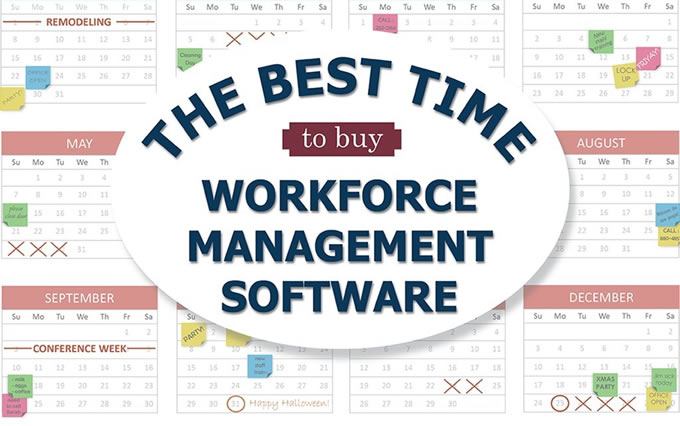Behind every prosperous business is a team of motivated employees that value the success of the company. Employee happiness is an incredibly important measure of a company's success, in fact, 36% of employees said that they would willingly give up $5,000 a year in salary if it meant they would be happier at work.

Plus, happy employees are more productive. A recent study even found that happiness resulted in a 12% increase in productivity at work.

Fortunately, there are many initiatives that have been proven to increase happiness in the workplace. Let’s explore a few ideas that may help boost employee morale, and performance, at your company.
Foster a Sense of Community
When employees feel that they are truly part of a team, they find more fulfillment in their work and role in the company. Solidarity and feelings of isolation can quickly lead to unhappiness in employees, so it’s important to establish a work culture that encourages teamwork and communication. Creating a "team culture" not only improves employee retention, but also paves the way for progress and innovation. Team members will be more likely to approach coworkers with their ideas, and business owners often find that problems are solved more efficiently with coworkers who are willing to work together to find solutions.
Building a work culture that thrives on teamwork and communication takes some time and effort to establish, however, the benefits will more than make up for it. Organizing events is a great way to get started - delegate planning duties to volunteers, and emphasize that attendance for events outside of work is optional. Put careful thought into what types of events you should have, for example, if most of your employees have families you may want to consider a family-friendly event that’s fun for kids and adults.
Business owners can also encourage a sense of community in the workplace by facilitating team projects. Working together toward a common goal is a great way to foster positive relationships among coworkers, and those relationships will help your employees feel more excited about the team, and company, they’re representing.
Create Incentives
Incentives for performance and established, goal-oriented programs are another great way to boost morale and employee happiness. Employees are motivated by different factors: some value money, others prefer recognition, and many are encouraged by the prospect of advancement within the company. While it isn’t a business owner’s primary responsibility to provide personalized incentives for every individual employee, leadership can establish clear incentives for hard work and determination.
For incentives to work properly, they need to be communicated clearly and applied consistently across the team. A good starting point is to first determine what should be incentivized (new sales, perfect attendance, etc) and match incentives with each initiative. It’s much easier to be consistent with incentives if the requirements are tangible and measurable: for example - perfect attendance for one full year, with no unexplained absences, is easy to track. Another idea for innovative, forward-thinking companies is to establish an ongoing learning program. One industry-related article or blog read, for instance, could result in a point, and X amount of points equals an incentive.
Listen to Your Employees
Employees should always feel comfortable approaching management with their concerns, thoughts and ideas. Leaders who take the time to listen to their employees have the ability to find solutions for any problems that the employee is experiencing at work. Employees should be treated as individuals with unique preferences - and employers can quickly find out how each employee is feeling in their role by taking the time to listen.
One surprising metric that demonstrates the value of listening to employees? According to a recent Gallup survey, only 13% of employees feel that they are engaged at work. When employees aren't feeling engaged, they are less productive and overall company efficiency decreases significantly. Business owners, and leadership, can impact this statistic by welcoming employees to share their ambitions and career goals, as well as communicate how they're feeling in their role.

Listening to your employees involves more than just sitting back and taking notes. Employees need to know that they can trust leadership to truly care about what they’re telling them, and they need reassurance that they will not be reprimanded for reaching out. Quarterly, or annual, check-ins are a great way to provide the opportunity for employees to discuss their feedback with managers, and vice-versa. Implementing a check-in schedule across the team will ensure that every employee has the opportunity to be heard.
Create a Comfortable Workspace
The work environment that you provide for your employees has a huge impact on employee happiness and retention. While there are certain parts of the location that you may not be able to change, like geographic area or the size of the building, there are certainly some steps that you can take to ensure employees are comfortable and happy in the workplace.
- Keep It Organized and Clean-
It’s well worth the cost to hire a cleaning crew that is able to come in after hours on a regular basis. While it’s important to emphasize that employees should take the initiative to clean their spaces, there are always spaces that will not get thoroughly cleaned during work hours. Employees will appreciate a clean office, and so will clients and interviewees. - Ask for Feedback-
For some employees, a comfortable work setting will require more than a clean, tidy workspace. Employees with back problems, for example, may benefit from an upgrade to the office chairs and furniture. Other employees may define a comfortable workspace as one that is well-lit, soundproof, or centrally located. While business owners can’t fulfill every request, it’s extremely valuable to hear direct feedback from employees regarding their workspace preferences. Many companies send regular surveys that ask employees to provide feedback on the work setting. Other companies offer each employee a budget that can be utilized for improvements to his or her personal space - like a more supportive chair, or headphones to block out noise. - Establish and Enforce Office Guidelines-
Every office needs to establish clear, fair rules that should be enforced to improve happiness in the workplace. If an employee’s position requires careful calculation or writing, for example, a loud workplace with lots of chatter will result in frustration and lack of productivity for that employee. After you determine which rules should be put in place, be mindful of whether your team is following through and abiding by the office policies. New changes may require time and a few reminders for them to become fully ingrained in the workplace culture. Be sure to get your employees’ feedback on any disruptions or areas of improvement that they can identify, as well. It will mean a lot to each of your employees if you show that you value their comfort. - Keep the job fresh and interesting:
Boredom can reduce motivation and even lead employees to seek opportunities outside your company. Help your staff find ways to take a fresh approach to repetitive tasks and seek their input as to how they can make their job more challenging and interesting. - Encourage creativity:
An extremely effective employee motivation idea is to encourage your staff to think outside the box and take “reasonable” risks. Refrain from criticizing them if their new course of action doesn’t always work out — instead, help them find ways to learn from their mistakes. - Pay Attention to Temperature-
A quick way to cause unhappiness in the workplace is to neglect the temperature in the office. How do you choose the perfect temperature for your office? Well, it varies. According to most research, an optimal office temperature falls between 70 and 73 degrees. Seasonality plays a role in the ideal temperature, of course, as employees will arrive to the office in varying layers of clothing. Although it’s a straightforward concept, ideal temperatures in the workplace do increase productivity, so don’t overlook the importance of maintaining the right temperature for every season.

Provide Career Development Opportunities
If you have a great hiring process in place already, you should have a team of employees who are motivated to grow and improve in their roles. That level of motivation can either make, or break, a company’s long-term success. If business owners, and managers, are willing to nourish that enthusiasm, they will see their employees thrive in their positions and the company will flourish. Alternatively, if career progression and enthusiasm are not rewarded, employees will become easily discouraged and seek alternative opportunities that offer more career advancement options.
With studies showing that 68% of employees feel their managers are not engaged in their career development, it's become increasingly important for businesses to encourage growth and career opportunities within the company. A great way to consider this is to think of the time and energy that you spend in training your employees. If you value your employees’ goals and career paths, you are equipped to provide the tools and opportunities that will help them get there. Hopefully, those employees will reward you with loyalty and commitment. Adversely, failing to provide career advancement opportunities for your employees means high-turnover and wasted time due to frequently training new employees.
Provide AdequateTraining
One of the most significant factors in employee happiness, and retention, is the time you invest in training your employees. Here's one telling statistic: nearly 40% of employees who received inadequate job training leave within six months of starting. What does this mean for a business? For departing millennials, it means that it will cost a business, on average, between $15,000 to $25,000 to replace them. Small businesses - particularly newer companies - cannot afford to constantly replace and re-train employees.

How does training play into employee happiness? Your employees need to know what is expected of them in their role, and what is considered adequate job performance. There are not many things that are more stressful to a new employee than the uncertainty of whether or not they are meeting expectations. Furthermore, inadequate training can lead to mistakes, lack of confidence, and uncertainty. All are factors that contribute to employee unhappiness, and all can be addressed with sufficient training from day one.
Business owners, and managers, can benefit from implementing a well-planned training program that is clearly communicated to the new employee. Senior employees are encouraged to take on additional leadership and training opportunities. Goals for the employee should be established early on, and many companies find success by providing supporting materials and resources that complement the training process.
Open communication between employees and managers is extremely important early on, and it’s helpful to schedule times in advance to meet one-on-one. These meetings will prove to be invaluable for both employer and employee, as the employee can ask for more guidance on certain subjects, and the employer can begin to learn more about the employee’s goals, ambitions, and valuable skills.
Lead by Example
Many studies have shown that humans tend to adopt the behavior and mindset of those around them. Having an optimistic outlook, paired with a strong work ethic, will not only boost employee morale but will encourage others to adopt a positive attitude in the workplace.
Leading by example does not fall solely on the shoulders of managers - it begins with upper management and owners of the company. Business owners should work hard to create a positive culture and encourage managers to adopt a constructive mindset. Managers, in turn, can directly influence the mentality of the team by displaying a positive outlook in the workplace.
Happiness is contagious, but it has to start somewhere. Whether you’re the CEO of a Fortune 500 company, or a brand new employee at a local business, you can be a leader by the way you conduct yourself and approach challenges. If employees see higher-ups - or coworkers - make an effort to be a positive asset to the team, those employees will receive validation that positivity is the norm.
The Value of Employee Happiness
Although the true, long-term impact of employee happiness is hard to measure, it’s easy to tell when a company has happy employees. Those companies are often efficient, productive and able to retain employees at a higher-than-average rate. If you meet one of their employees, you will likely hear them talk about what they love about the job, rather than the parts they don’t enjoy.
For business owners, caring about your employees’ happiness should be a priority, not an afterthought. Statistics prove that happiness is more profitable for companies, but the true value is far greater than its monetary worth. A company with happy employees is a company that attracts motivated candidates. Motivated candidates become motivated employees, and motivated employees generate significant success for every type of business.
In today’s fast-paced, competitive world, it takes more than a good business plan and adequate funds to succeed and withstand the test of time.
It requires a great team to steer the company toward progress, and if that great team involves happy employees, the journey will be much smoother.



